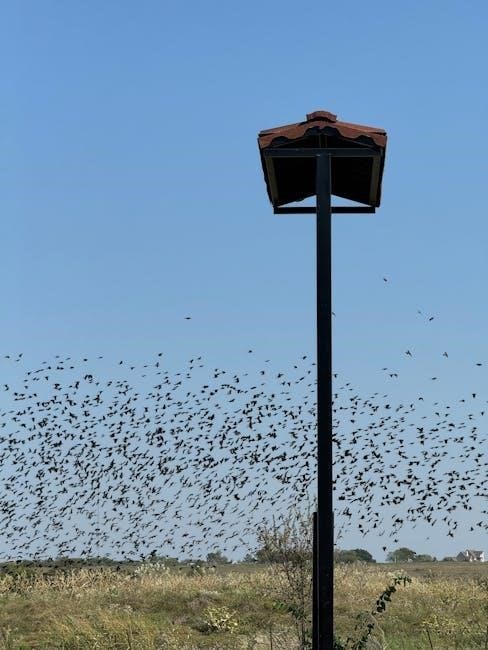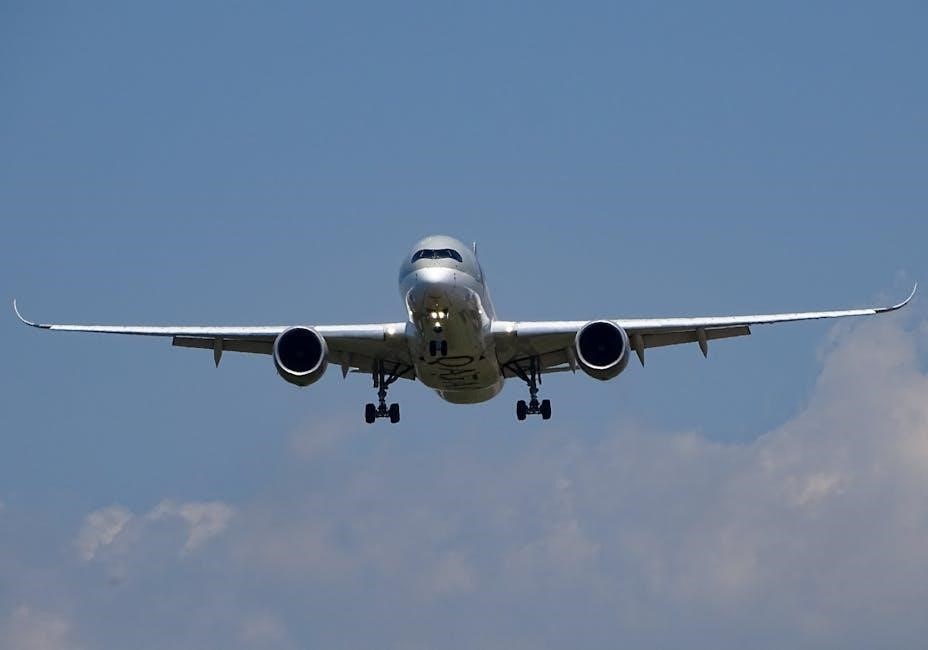Air masses and fronts are fundamental concepts in meteorology, shaping weather patterns by interacting between contrasting air masses. Understanding their dynamics aids in predicting weather changes.
What Are Air Masses?
An air mass is a large body of air with relatively uniform temperature and humidity characteristics. It forms over a homogeneous source region, such as oceans or continents. Air masses are classified based on their source region’s latitude (polar or tropical) and surface type (maritime or continental). For example, a continental polar air mass is cold and dry, while a maritime tropical air mass is warm and moist. These characteristics influence weather patterns when air masses interact with other air masses or fronts.
What Are Fronts?
A front is the boundary between two contrasting air masses. It forms when a mass of air is replaced by another with different temperature and humidity characteristics. Fronts are classified into types like cold, warm, stationary, and occluded fronts, each with distinct weather impacts. For instance, a cold front occurs when a cold air mass pushes under a warm air mass, often causing clouds, precipitation, and temperature drops. Understanding fronts is crucial for predicting weather changes and storm systems.
Key Differences Between Air Masses and Fronts
Air masses are large bodies of air with uniform temperature and humidity, while fronts are boundaries between contrasting air masses. Air masses influence weather over vast areas, but fronts trigger immediate changes like precipitation and temperature shifts. Unlike air masses, fronts are dynamic and lead to weather instability. Air masses form over homogeneous surfaces, while fronts develop when air masses collide. This distinction is vital for understanding weather patterns and forecasting. Fronts are the interfaces where air masses interact, causing significant meteorological events.

Types of Air Masses
Air masses are classified based on their source regions: continental (land) or maritime (ocean), and polar or tropical, resulting in four primary types.
Continental Polar Air Mass
A Continental Polar Air Mass forms over large land areas in polar regions, characterized by cold, dry air due to low humidity from land surfaces. These air masses develop primarily in winter when temperatures over continental regions drop significantly. They bring cold, stable conditions, often resulting in clear skies and fair weather. However, when they move into warmer regions, they can cause significant temperature drops and are associated with cold fronts, leading to cloud formation and precipitation as the cold air pushes warmer air upward.
Continental Tropical Air Mass
A Continental Tropical Air Mass is a warm, dry air mass that forms over vast desert regions. It is characterized by high temperatures and low humidity, resulting from its origin over land. These air masses are typically stable, leading to clear skies and minimal cloud formation. They often bring hot, sunny days and cool nights due to the low moisture content; When a Continental Tropical Air Mass interacts with other air masses, it can create significant weather changes, such as the formation of dry lines or contributing to the development of certain types of fronts.
Maritime Polar Air Mass
A Maritime Polar Air Mass is a cool, moist air mass that forms over large bodies of cold water, such as polar oceans. It is characterized by low temperatures and high humidity, creating overcast skies and light to moderate precipitation. These air masses are significant in coastal regions, where they often bring fog and mist when moving ashore. Their interaction with other air masses can lead to the formation of fronts, influencing regional weather patterns significantly.
Maritime Tropical Air Mass
A Maritime Tropical Air Mass originates over warm ocean waters, characterized by high temperatures and high humidity. This air mass is unstable, leading to the formation of cumulus and cumulonimbus clouds, which can produce heavy rain and thunderstorms. When it moves over land, it brings warm, moist air that often results in precipitation. This air mass significantly influences weather in coastal and tropical regions, contributing to their characteristic warm and humid climates.

Formation of Fronts
Fronts form when contrasting air masses collide, causing one to push under or over the other, creating a boundary that influences weather patterns significantly.

Cold Front Formation
A cold front forms when a cold air mass moves under a warm air mass, pushing it upward. This boundary creates a steep slope, leading to rapid cloud formation and precipitation. As the cold air advances, it displaces the warmer air, resulting in cooling temperatures and changing weather conditions. The interaction between these contrasting air masses drives significant weather events, making cold fronts key players in storm systems and atmospheric changes.
Warm Front Formation
A warm front forms when a warm air mass advances over a cooler air mass, forcing the cooler air upward. As the warm air rises, it cools, leading to cloud formation and precipitation. This process occurs more gradually than cold fronts, often producing stratiform clouds and steady rain. The boundary between the contrasting air masses drives weather changes, with temperatures gradually rising as the warm front moves through. This slow ascent results in less turbulent but sustained weather patterns compared to cold fronts.
Stationary Front Formation
A stationary front forms when two air masses meet but neither advances, creating a boundary with little movement. This occurs when the opposing forces of the air masses are balanced, resulting in a stable weather system. The front remains in place, often causing prolonged weather patterns such as light drizzle, fog, or overcast skies. Unlike cold or warm fronts, stationary fronts do not move significantly, leading to persistent conditions. This stability makes them less dynamic but impactful in maintaining regional weather over time.
Occluded Front Formation
An occluded front forms when a faster-moving cold front overtakes a slower-moving warm front. The cold air mass pushes the warm air upwards, trapping it above the cold air. This creates a wedge-like structure where the warm air is no longer in contact with the ground, resulting in an occluded front. The front can be further divided into cold and warm occlusions, depending on which air mass is dominant. This interaction leads to significant weather changes, including clouds, precipitation, and potential thunderstorms, as the water vapor in the warm air condenses. Occluded fronts are represented on weather maps with specific symbols combining elements of both cold and warm fronts, indicating the complex interaction of air masses.

Impact of Fronts on Weather
Fronts significantly influence weather by triggering temperature changes, cloud formation, and precipitation. They force air masses to rise, cool, and condense, leading to storms and weather shifts.
Cloud Formation and Precipitation
Clouds form as warm, moist air rises and cools, condensing into visible vapor. At cold fronts, rapid uplift creates towering cumulonimbus clouds, often causing heavy rain or thunderstorms. Warm fronts produce layered stratocumulus clouds, leading to steady, light precipitation. The clash of air masses at fronts forces moisture to condense, resulting in various cloud types and precipitation patterns that are essential for weather forecasting and understanding storm development.
Temperature Changes
Fronts significantly influence temperature changes as contrasting air masses interact. Cold fronts bring rapid temperature drops, pushing warm air upward and replacing it with cooler air. Conversely, warm fronts lift cooler air, gradually raising temperatures. The clash of air masses creates sharp temperature gradients, leading to noticeable weather shifts. Understanding these changes is crucial for forecasting, as they often signal approaching storms or stable conditions. Temperature fluctuations near fronts are key indicators of weather transitions, making them vital for meteorological analysis and public weather alerts.
Wind Patterns

Wind patterns are significantly influenced by the movement and interaction of air masses and fronts. Cold fronts are associated with strong, shifting winds as the denser cold air pushes beneath the warmer air, creating abrupt wind direction changes. Warm fronts produce more gradual wind shifts as the lighter warm air rises over the cooler air. These wind changes are crucial for forecasting, as they often indicate the approach of weather systems. Meteorologists use wind barbs and arrows on maps to illustrate these patterns, helping predict storm tracks and weather transitions accurately.
Identifying Fronts on Weather Maps

Fronts on weather maps are shown as lines with specific symbols: triangles for cold fronts, circles for warm fronts, and alternating symbols for occluded fronts. Colors like blue for cold fronts and red for warm fronts help differentiate them. Additional features, such as arrows indicating wind direction and temperature changes, aid in pinpointing front locations and movements. These visual cues are essential for accurate weather forecasting and analysis.
Symbolic Representation of Fronts
Fronts are depicted on weather maps using distinct symbols and colors. Cold fronts are shown with blue lines and triangular markers, while warm fronts use red lines with circular markers. Occluded fronts are represented by alternating triangles and circles on a purple line. These symbols indicate the direction and type of air mass movement. Additional features, such as arrows showing wind direction and temperature gradients, enhance understanding. This visual system allows meteorologists and students to quickly identify and analyze front types, aiding in accurate weather prediction and study. Proper labeling ensures clarity and precision in meteorological analysis.
Labeling Air Masses and Fronts
Labeling air masses and fronts involves using standardized symbols and abbreviations to clearly identify their locations and types on weather maps. Cold fronts are marked with blue lines and triangles, while warm fronts use red lines and circles. Occluded fronts combine these symbols on a purple line. Air masses are labeled with specific abbreviations, such as ‘mP’ for maritime polar and ‘cT’ for continental tropical. Accurate labeling helps meteorologists and students analyze weather patterns and predict changes effectively. Consistent labeling ensures uniformity across maps and resources for better understanding and communication.
Worksheet Answer Key
Cold front forms when cold air replaces warm air. Label air masses (cP, mT) and fronts (cold, warm) on maps. Answer key provides correct responses and explanations.
Common Questions and Answers
What forms when a cold air mass replaces a warm one? A cold front forms.
Why do clouds form at the leading edge of a cold front? Cold air forces warm, moist air upward, cooling it and causing condensation.
How do you label air masses on a map? Use symbols like cP (continental polar) or mT (maritime tropical).
What happens when a warm front occurs? Warm air rises over cool air, creating clouds and precipitation.
How do fronts influence weather? They cause temperature changes, cloud formation, and precipitation.
These questions and answers help clarify key concepts in understanding air masses and fronts.
Case Studies and Diagram Analysis
Analyzing diagrams of air masses and fronts enhances understanding of weather patterns. In a cold front case study, cold air pushes warm air upwards, causing cloud formation and precipitation. Diagrams use symbols like cP for continental polar air masses. By examining these, students identify interactions and resulting weather changes. Such analysis provides practical insights into meteorological concepts, aiding in accurate weather prediction and enriching students’ understanding of atmospheric interactions.

Air masses and fronts are essential for understanding weather patterns, enabling accurate predictions of temperature, precipitation, and wind changes, making them vital in meteorology and weather forecasting.
Understanding air masses and fronts is crucial for analyzing weather patterns. Air masses are large bodies of air with uniform temperature and humidity, shaped by their source regions. Fronts form when these air masses interact, creating boundaries that influence weather conditions. There are four main types of air masses: continental polar, continental tropical, maritime polar, and maritime tropical. Fronts, such as cold, warm, stationary, and occluded, drive weather changes, including cloud formation, precipitation, and temperature shifts. Recognizing these elements on weather maps enhances forecasting accuracy and meteorological understanding.
Importance of Understanding Air Masses and Fronts
Understanding air masses and fronts is essential for predicting weather patterns and climate conditions. These concepts help explain temperature changes, precipitation, and wind shifts. By identifying air masses and fronts, meteorologists can forecast weather accurately, aiding in agriculture, aviation, and emergency preparedness. This knowledge also enhances public safety by providing early warnings for severe weather events, such as storms or heatwaves. Thus, studying air masses and fronts is vital for both scientific research and practical applications in everyday life.
Recommended Resources for Further Study
provide comprehensive insights. Websites like Khan Academy and educational forums also offer interactive lessons and case studies. These resources are ideal for students and enthusiasts seeking to master air masses and fronts.



